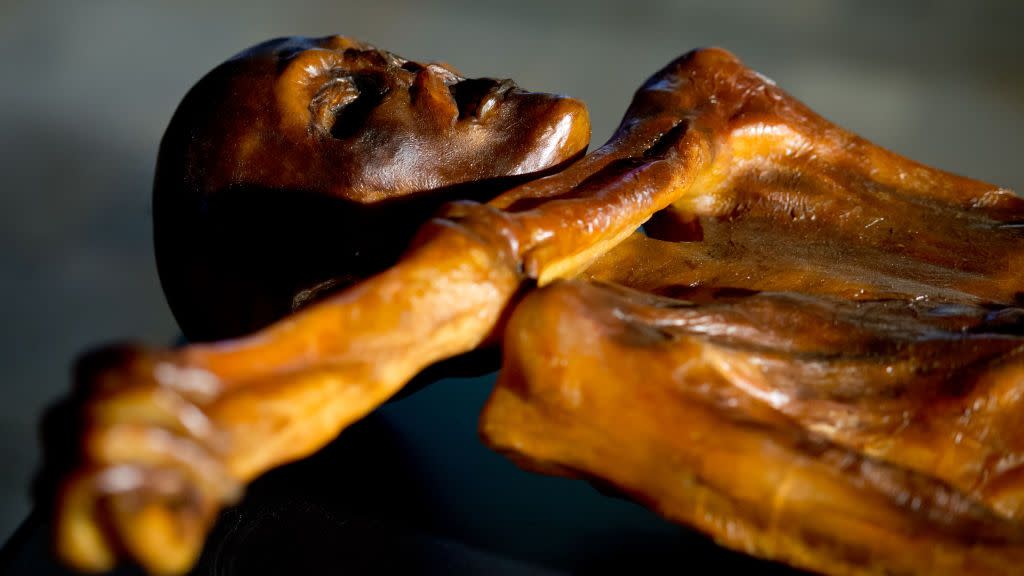An Alpine Mummy’s Mysterious Tattoos Have Upended Archaeological Theories

- Oops!Something went wrong.Please try again later.
The 5,000-year-old Ötzi the Iceman mummy had 61 tattoos preserved on his body, and nobody knows the method by which they got there.
A new research study experimented with differing tattoo tools and methods to get us closer to understanding Ötzi’s ink.
It appears Ötzi’s tattoos were made by using either a piece of bone or copper awl.
Ötzi the Iceman didn’t have a full tattoo sleeve, but he may have been well on his way before meeting his death in the Italian Alps over 5,000 years ago. It’s those 61 tattoos—or tattoo-like marks—on Ötzi that apparently have both researchers and tattoo artists intrigued enough to start tattooing themselves, hoping to find just how Ötzi got his ink.
There’s been a series of guesses floating about regarding just what made the tattoo marks on Ötzi’s wrist, legs, back, and abdomen ever since he was uncovered by hikers in 1991, but there’s really been no scientific evidence to back them up. That’s why Aaron Deter-Wolf of the Tennessee Division of Archaeology partnered with New Zealand tattoo artists Danny Riday to test out the methods. They published a study on their findings in the European Journal of Archaeology.
The team tattooed Riday using eight different tools and four tattooing techniques in the same exact designs as found on Ötzi. They chronicled the way the wounds healed, the lines of the ink, and the way the tattoos aged, and compared Riday’s tattoos with those of Ötzi to find the closest match.
“We ultimately proposed that Ötzi’s tattoos were made by puncture, likely using either a bone of copper awl,” Deter-Wolf told ScienceAlert. “Those types of artifacts appear in the archaeological record of the region, but none have ever been identified as tattooing tools. We hope this paper will inspire archaeologists to reassess how artifacts may have been used, and maybe discover actual Copper Age tattooing tools.”
Tools were the first key in the experiment—animal bones, obsidian, copper, boar tusk, and a modern steel needle were all part of the process. All tools in the experiment were crafted using traditional or pre-electric technologies, when possible, the authors wrote when discussing the study, to ensure continuity with archaeological materials. Techniques included hand-tapping, hand-poking, incision, and subdermal tattooing, the last of which requires a bone to puncture the skin twice.
The finding that hand-poking with either animal bone or a copper awl is the most likely method used differs from early theory that gained traction in the mainstream discussion of Ötzi—that the tattoo-like markings were created by an incision getting filled with plant matter that was then set on fire.
“Popular discussions of the Iceman describe his tattoos as having been made by incision, first cutting the skin, and then rubbing in pigment from the surface,” the authors wrote.
The team found that the Ötzi tattoos were not only a hand-poked method with a single-pointed tool, but probably not made using the incision technique popularly discussed, based on matching the wounds, line widths, and ink diffusion.
“There’s absolutely no proof of that, and over time the bit about fire got left behind, but the idea of their being incised persisted,” Deter-Wolf told ScienceAlert. “Most of the archaeologists who have discussed Ötzi’s tattoos in recent years are upfront that we don’t know how they were made, but the idea still appears in just about every popular media discussion.”
Each tattoo pattern was executed with a single tool type and technique, and featured both commercial black tattoo ink and a soot-based ink harvested from burning kauri tree resin mixed with powdered charcoal, alcohol, and coconut oil in order to “examine possible variations between natural and commercially produced tattoo pigment.”
“Our findings reveal that there are discernible variations in tattoos created using different tools and techniques,” the team wrote. “This data may be applied to the study of preserved remains from archaeological and museum collections, as well as to analysis of historical imagery and traditions, to illuminate previously unknown aspects of the associated cultures.”
You Might Also Like

